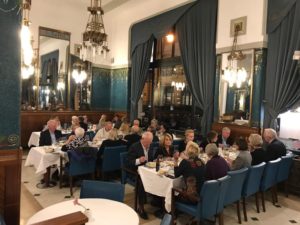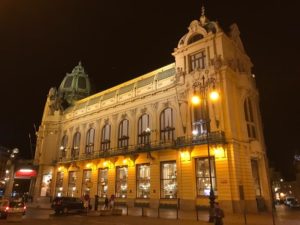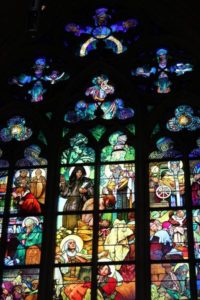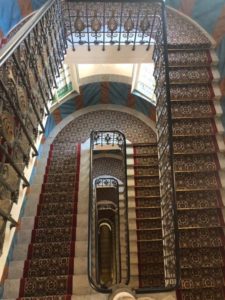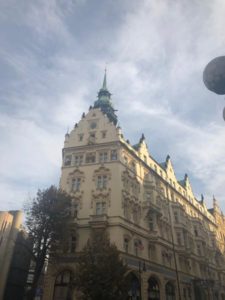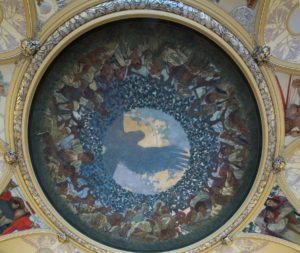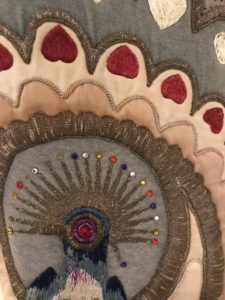Czeching out Prague’s Art Nouveau Masterpieces
EVENTS > STUDY TRIPS ABROAD
STUDY TRIP ABROAD FALL 2018 IN REVIEW
During the Trust’s 2018 fall Study Trip Abroad to Prague and Vienna, we had the great pleasure of visiting many iconic castles, museums, and historic sites. A range of styles and movements were encountered, but our members were particularly wowed by the extensive Art Nouveau treasures found in Prague.
Art Nouveau is an international style popular from 1890–1910 and marked by inspiration taken from nature. Often mimicking organic forms resembling the stems of plants, leaves, and roots, this art form is fluid, whimsical, and bright. The movement encompassed a wide range of fine and decorative arts and architecture and brought a new fashion to Prague that blurred the lines between the fine and applied arts. Prague became one of the major centers of Art Nouveau design. Alphonse Mucha, a Czech national, was one the style’s most prolific figures. Although many identify Mucha with his vibrant Parisian posters, we learned that he was also quite skilled in a variety of other media, including furniture, jewelry, sculpture, and theatrical set design. Mucha and the greater Art Nouveau influence in Prague is apparent at every corner.
The group jumped right into our exploration of the style from the moment we checked into the Hotel Paris, located in the center of Prague’s Old Town. Built in 1907 by Czech architect Jan Vejrych, this building is widely regarded as a model example of the Art Nouveau and was declared a historic monument in 1984. While Vejrich focused on the overall structure, the hotel’s intact interiors include an attractively paneled café and a mirrored restaurant with mosaics and marquetry designed by architect Antonín Pfeiffer. Colorful figurative decorations are found on the corner façade of the gabled, Gothic-inspired exterior, and the arched entrance features vibrant ceramic mosaics by the painter Jano Köhler.
We did not need to wander far to find other exquisite representations of the movement. The splendid Obecní Dům (the Municipal House) was only a stone’s throw from our hotel’s lobby. Situated in Republic Square on the site of a Bohemian palace, the Obecní Dům is thought to be the finest piece of Art Nouveau architecture in Prague. Designed by Osvald Polivka and Antonin Balsanek, it opened in 1912 and contains several restaurants, an exhibition space, and a concert hall. Both the interior and exterior are covered in allegorical mosaics and sculptures celebrating the city and its prominent residents, making the site a symbolic choice for the public reading of the Czechoslovak Declaration of Independence on October 18, 1918.
The interior décor of the Municipal House was executed by a dream team of renowned artists, including Mucha, Jan Preisler, and Max Svabinsky, and is a truly magnificent sight to encounter. Participants enjoyed the special opportunity for a private evening tour of this impressive building. Mucha was commissioned to decorate the circular salon of the Lord Mayor’s Hall. His decorative scheme celebrates the heroic past of the Czech people and the unity of the Slav nations. The Slavic Concord on the circular ceiling is supported by eight pendentives on which civic virtues are personified by figures from Czech history. Replete with the original furnishings and curtains designed by Mucha, this room is a stunning essay on the Art Nouveau movement. Following our tour, we dined at the French Restaurant located on the first floor, which incorporates Art Nouveau features such as the large curvilinear windows, detailed stucco ceilings, allegorical pictures, geometric ornaments with figural decorations, and massive and ornate chandeliers.
We delighted in discovering Art Nouveau hidden in the most unlikely of places. For example, one would not expect to discover any traces of the style at the St. Vitus Cathedral (c. 1344) located in the Prague Castle complex. However, in the early 1900s, Mucha was commissioned to design a stained-glass window to commemorate the Millennium Jubilee of the Czech patron saint St. Wenceslas. The impressive creation features the Saint as a boy accompanied by his grandmother and was installed in the north nave in 1931. A wooden crucifixion by the Art Nouveau sculptor Frantisek Bilek is also displayed in the cathedral.
A special highlight of our time in the Czech capital was marked by a private visit to the Mayor’s Residence. The apartment was begun in 1925 by architect František Roith, who instigated Prague’s transition to the Art Deco style, and impressive Art Deco landmarks are found throughout the city today. The initial plan incorporated a synthesis of Czech Art Nouveau and Art Deco elements but the final design is firmly in the latter mode. The Mayor’s Residence is also a rare example of a perfectly preserved interior from this period. The stunning apartment includes the original light fixtures and soft furnishings that were stored away in closets during the communist occupation of Prague. Following the Velvet Revolution in 1989, the city used photographs to reinstall the decorations in a manner consistent with Roith’s original vision.
There is no doubt that these stylistic movements, albeit short lived, had a lasting impact in Prague. We felt fortunate to have the opportunity to discover the rich history of design in the Czech Republic and enjoyed sharing our observations with our members.
Complete a digital puzzle from this trip on our Puzzles webpage!

